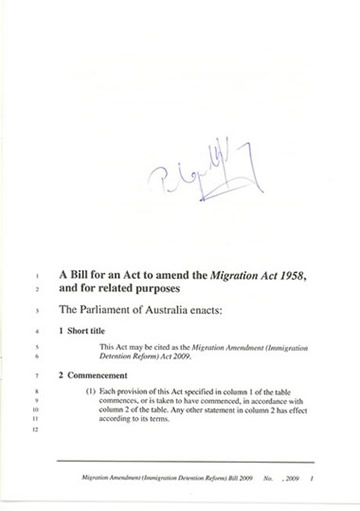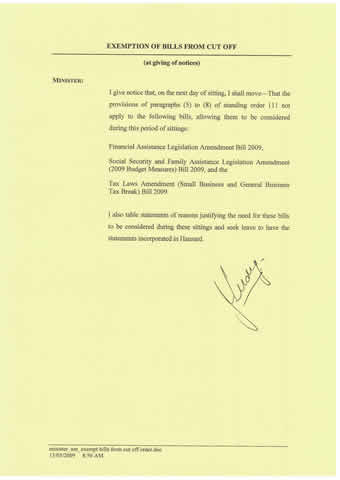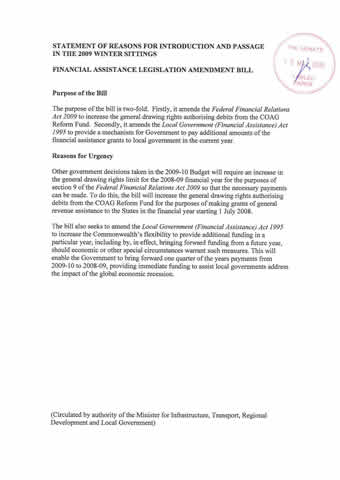111 Initiation
-
A bill, unless received from the House of Representatives, shall be initiated by a motion for leave to bring in the bill, specifying its intended title, or by a motion for a committee of not less than 2 senators to prepare and bring it in, or by an order of the Senate.
-
The senator having leave, or one of the committee appointed to bring in a bill, shall present a signed copy to the Senate.
-
The title shall agree with the order of leave, and no clause shall be inserted in a bill which is irrelevant to its title.
-
A bill not in accordance with the order of leave, or with the rules and orders of the Senate, shall be ordered to be withdrawn.
-
Where a bill:
-
is first introduced in the Senate by a minister in a period of sittings; or
-
is received from the House of Representatives and was introduced in that House in the same period of sittings; or
-
is received from the House of Representatives after the expiration of two-thirds of the total number of days of sitting of the Senate scheduled for that period of sittings, and a motion is moved for the second reading of the bill, debate on that motion shall be adjourned at the conclusion of the speech of the senator moving the motion and resumption of the debate shall be made an order of the day for the first day of sitting in the next period of sittings without any question being put.
-
Paragraph (5) does not apply to a bill introduced in the Senate or received from the House of Representatives within the first two-thirds of the total number of days of sitting of the Senate scheduled for the first period of sittings after a general election of the House of Representatives, but consideration of such a bill shall not be resumed after the second reading is moved in the Senate unless 14 days have elapsed after the first introduction of the bill in either House.
-
Paragraph (5) does not apply to a bill received by the Senate again in the circumstances described in the first paragraph of section 57 of the Constitution.
-
In paragraphs (5) and (6) “period of sittings” means a period during which the Senate adjourns for not more than 20 days.
Amendment history
Adopted: 19 August 1903 as SOs 177 to 180 (corresponding to paragraphs (1) to (4))
Amended:
- 13 February 1997, J.1445, 1447 (to take effect 24 February 1997) (addition of what are now paragraphs (5), (6) and (8) which incorporated a continuing order on the “cut-off”, as amended to take into account the impact of a new Parliament)
- 14 May 2003, J.1797–99 (insertion of paragraph (7), modifying the cut-off to exempt potential double dissolution triggers on their second appearance)
1989 revision: Old SOs 185 to 188 combined into one, structured as four paragraphs and renumbered as SO 111, paragraphs (1) to (4); language modernised and streamlined
Commentary
The original standing orders were drawn from those of the South Australian House of Assembly which the Senate was using on a temporary basis, except for the predecessor to paragraph (3) on which there was extensive debate.[1] Paragraph (1) provides three methods of initiating a bill in the Senate apart from receiving it by message from the House of Representatives:
-
a motion moved on notice granting leave to a senator to bring in a bill;
-
a motion moved on notice establishing a committee of senators to prepare and bring in a bill;
-
an order of the Senate, agreed to by motion on notice, that a specified bill be brought in.
The second and third methods give the Senate the option of directing that particular legislative activity be initiated without being dependent on an individual senator taking action. In practice, bills are now invariably initiated in the Senate using the expedited proceedings under SO 113 (see below) and motions under this standing order, which take the form “That leave be given to introduce a Bill for an Act …”, have not been used since 1987.
The fierce debate which took place in 1903 on the predecessor to paragraph (3) encapsulated the tensions between the traditionalists and the innovators, the latter led by President Baker. Rather than recommend the adoption of the equivalent House of Assembly standing order,[2] the Standing Orders Committee proposed a variation:
The Title shall agree with the Order of leave, and no clause shall be inserted in any such draft not relevant to the subject matter of the bill.
[Marginal note: Clauses to come within the Title]
The apparent intention was to ensure that the bill as introduced complied with the grant of leave by the Senate to the introducing senator, as indicated by two measures:
-
the title of the bill being identical with that in the authorising motion; and
-
the bill not containing irrelevant matters.

A senator introducing a bill presents a signed copy of it
The first measure was unexceptionable but how to assess the second measure divided the Senate. Senator Symon (FT, SA), unofficial Opposition Leader, argued for retention of the House of Assembly version of the standing order with the title of the bill as a measure of its appropriate content operating as a simpler and less restrictive rule than the one proposed. He alluded to the relatively new practice, apparently introduced by then Minister for Trade and Customs, Charles Cameron Kingston, MHR, when South Australian Attorney-General (later Premier), of making bill titles more elastic with the addition of the words “and for other purposes” at the end. President Baker characterised Senator Symon’s position as a retrograde step, harking back to old House of Commons practice, adopted by most state parliaments but found to be too restrictive on the originator of a bill as titles became shorter. For Baker, the issue was allowing senators the greatest freedom and power. For Symon, it was the difficulty for the chair in determining relevance to subject matter as opposed to relevance to the title. While Symon quoted Erskine May on the role of the title, Baker quoted Erskine May on a new House of Commons standing order, adopted in 1854, superseding the requirement that amendments should be within the scope and title of the bill, and providing instead for amendments relevant to the subject matter of the bill. Baker may have been anticipating matters on this point, which were more appropriately covered in what is now SO 118(1). Symon was successful in moving an amendment to replace “not relevant to the subject matter of the bill” with “foreign to its title”, having also succeeded in replacing “draft” with “Bill”.[3] The substantive amendment was carried by 12 Ayes to 11 Noes. In any event, it was not a point of great moment since there was nothing to prevent amendments at the committee stage which might necessitate an amendment to the title (see SO 118).
The 1989 revision modernised the language of this group of standing orders in two major respects, the first of which was to replace the term “foreign” with “irrelevant”. The second point of modernisation was the deletion of references to “Public Bills” in the chapter title and in paragraph (1). This term had been taken straight from the South Australian standing orders and had never had any meaning in the Commonwealth Parliament in the absence of any provision for “Private Bills”. As noted in the 1938 MS, all bills dealt with by the Commonwealth Parliament are “Public Bills” and the distinction is unnecessary.
Around this time, the growth in the number of bills being introduced and the concentration of bills on the Senate’s program in the last weeks of each sitting period caused senators to devise measures to mitigate this “end of sittings rush”. See Odgers’ Australian Senate Practice, 12th edition, Chapter 12, under “Deadline for receipt of bills from House” for both the statistics and an account of the development of these measures. Instigated by Senator Macklin (AD, Qld) in 1986, what became known as the “cut-off” is the imposition of a deadline on the receipt of bills from the House of Representatives. Pursuant to an order of the Senate, bills not received from the House by a certain date would not be considered by the Senate before the end of the period of sittings and would be automatically adjourned until the next period of sittings. Although employed for several years, the Macklin motion, as it was called, did not alleviate the problem and in 1993 a variation, proposed by Senator Chamarette (GWA, WA), was adopted. This variation, adopted as a permanent order of the Senate and subsequently modified,[4] involves the imposition of a double deadline. To be considered by the Senate in a period of sittings, a government bill is required to have been:
-
introduced in either House in a previous period of sittings; and
-
if first introduced in the House of Representatives – received by the Senate within the first two-thirds of the current period of sittings.

Senator Michael Macklin (AD, QLD) who initiated the first version of the bills cut-off order (Source: Commonwealth Parliamentary Handbook)
Bills may be exempted from these requirements by a resolution of the Senate. This resolution is familiarly known as “an exemption from the cut-off”.
This order was one of several recommended by the Procedure Committee for incorporation into the standing orders in 1996.[5] Before the report was formally adopted, however, a further variation was made to provide for arrangements at the beginning of a new Parliament when there can be no previous period of sittings.[6] In its earlier days, the order had been applied to individual periods of sitting and the impact of a new Parliament had not been anticipated when, by opposition amendment, it became a permanent order.
The most recent modification provides that the cut-off does not apply to bills received a second time by the Senate in the circumstances contemplated by s. 57 of the Constitution. This modification was made in 2003 on the recommendation of the Procedure Committee which stated that the rationale of the cut-off procedures was to ensure that senators have adequate time to examine bills and to avoid the end of sittings rush of bills. Neither consideration applied to a potential double dissolution trigger bill on its second appearance in the Senate after a three month interval. Although opposed by the minor parties, the amendment was adopted on 14 May 2003.[7]
A bill which is subject to the cut-off is listed on the Notice Paper as an order of the day for the first day in the next period of sittings and may therefore be found under “Business for future consideration”. A resolution exempting a bill from the cut-off makes it available for consideration immediately, subject to a further resolution to provide for its consideration in relation to other orders of the day on the Notice Paper for that day. This is normally achieved by a motion to rearrange business to give the bill a priority in the list of government business, in accordance with the general principle that the order of business as provided for in the standing orders and notified in the Notice Paper can be varied only by an explicit order of the Senate.
 |
 |
| Notice of a motion to exempt bills from the cut-off |
A proposal to exempt a bill from the cut-off must be supported by a statement of reasons
|